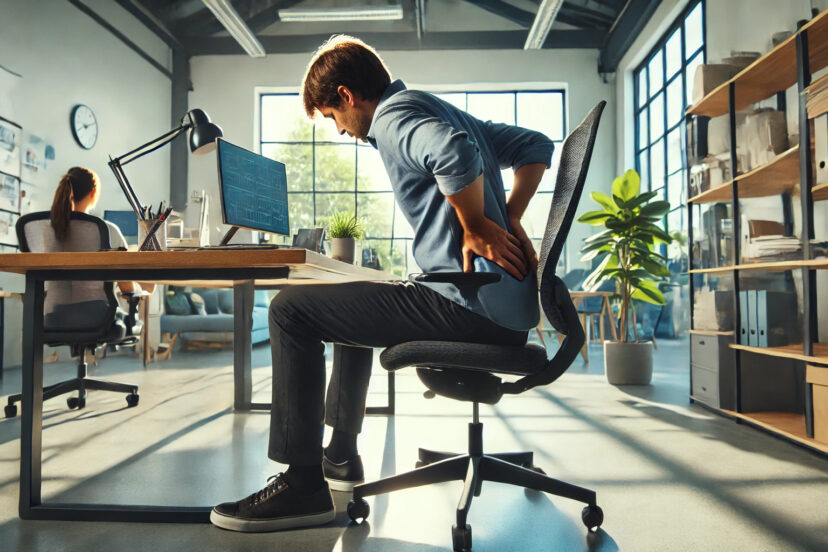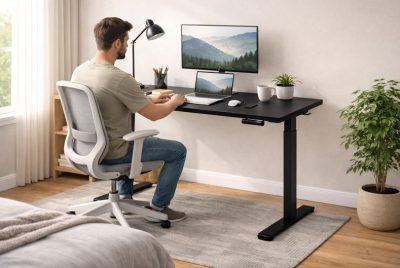Ergonomic Hazards: Protecting My Health at Work and Beyond
We may earn a commission for purchases made using our links. Please see our disclosure to learn more.
Hey there, fellow hustle-holic folks! Are you dealing with some neck, lower back, or wrist pains after a long tiring day at work? You’re not alone! The pain you’re experiencing is quite common for hardworking people like us. Imagine working for hours, sitting on a stiff chair without knowing that you’re actually putting stress on your whole body. If you don’t do something right now, that slight discomfort could turn into chronic pain. So, to help you prevent that, let’s talk about ergonomic hazards, how to deal with them, and keep ourselves healthy. Let’s dive right in!
What Exactly Are Ergonomic Hazards?
Let me break it down for you real quick. Ergonomic hazards are workplace things like office chairs and keyboards that can put a strain on your body because of poor design. Basically, these are bad work setups and habits that if you ignore them, can lead to nasty body aches or worse, some serious injuries like carpal tunnel syndrome. Maybe you’re using an office chair that doesn’t quite support your back or the way you hunch over your laptop for hours on end. Yep, those are ergonomic hazards you just didn’t notice. Or you did, but you just say to yourself, “Nah, it’s just a little discomfort”?
Two key studies highlight the importance of ergonomic interventions to reduce musculoskeletal disorders (MSDs). The first study on office workers emphasizes that adjustable chairs and desks can significantly lower MSD risks by improving posture and reducing strain ScienceDirect Study. The second study focuses on healthcare workers, identifying improper lifting techniques and repetitive tasks as major contributors to MSDs and recommending ergonomic training and assistive devices to enhance safety ResearchGate Study.

Why Should I Care About Them?
So, why should you care for these so-called ergonomic hazards? Well, if you don’t want to have serious injuries over time, then you should! Alright, let’s paint a picture: I’m grinding away at my computer, deep into work mode, and suddenly, a sharp pain shoots up my neck. “Ouch!” But, I push through because deadlines don’t wait. I don’t want to hear my boss shout at me again so… Fast forward a few weeks, and that occasional twinge has turned into a constant throbbing. Did it ring a bell? Trust me, I’m guilty of ignoring this pain because I thought it was nothing. We need to be mindful of these ergonomic hazards to prevent long-term health issues that can put a toll on our bodies. Do you have time to visit a physiotherapist’s office? I bet you don’t.
The Usual Suspects: Common Types of Ergonomic Hazards
Now that we’ve established why ergonomic hazards deserve our attention, let’s shine a light on the most common ones that might be lurking in our daily lives:
1. Awkward Postures
Ah, awkward postures… Sometimes we often get caught up in our workload we sit like a hunchback, right? Or maybe you’re scrolling on your phone to stay tuned with the latest trends while sitting in a bizarre position. Don’t lie to me, I know you probably sit like that! Slouching and trying to reach something my friend, can strain your muscles! Expect some back pain complaints at the end of the day.
2. Repetitive Movements
Want to know the perfect recipe for pain? Well… repetitive movements as if you had a song on repeat. Activities like typing incessantly, clicking a mouse, or even assembly line work can lead to overuse injuries like tendinitis. Our bodies crave variety, so repetitive motions can be a real pain—literally.
3. Forceful Exertions
Have you ever pushed a heavy door a couple of times a day? How about lifting a heavy laundry basket? Okay, so when we apply excessive force frequently, we’re inviting muscle strains and sprains into our lives unknowingly. Truth is, no one wants to pull a muscle doing mundane tasks right?
4. Contact Stress
Now who likes to lean on tables? I do that every time especially when I’m bored. Suddenly I noticed that it started to hurt after a while. Can you relate? If you’re nodding then that’s contact stress in action. It’s literally continuous pressure on a specific part of the body, which can compress nerves and blood vessels. That’s why it hurts after a while.
5. Poor Workstation Design
Let’s talk about that poorly designed workstation of yours. Maybe you’re using an unsupportive chair, a monitor at the wrong height, or a desk that’s too high or low. Well well, those things can force your body into all sorts of uncomfortable positions. And what can you expect? An appointment with a physiotherapist. I don’t think that’s going to be fun so better improve your workstation now!
Listening to My Body: Recognizing the Signs of Ergonomic Hazards
Our bodies are pretty good at sending up red flags when something’s off. Here’s what to watch out for:
– Persistent Pain and Discomfort: That nagging ache that just won’t quit is your body’s SOS signal.
– Numbness or Tingling: Feeling like pins and needles or losing sensation can indicate nerve issues.
– Stiffness or Reduced Mobility: Struggling to move joints or muscles as freely as before is a clear warning sign.
– Swelling or Inflammation: Your body’s way of shouting, “Hey, pay attention here!”
If any of these symptoms sound familiar, it’s time to take action before things escalate.

Taking Charge: Preventing Ergonomic Hazards Proactively
Alright, enough with the doom and gloom. The good news is, we have plenty of tools and strategies at our disposal to nip ergonomic hazards in the bud. Here’s how I approach it:
1. Revamping My Workstation
First up, I take a good look at my desk situation. Is my chair actually doing its job, or is it just a fancy way to make my back ache? Is my monitor at the right height, or am I giving myself a neck cramp? And are my keyboard and mouse set up so my wrists don’t look like they’re doing the twist? A couple of adjustments made my life easier. Bye bye body pains!
2. Embracing Regular Breaks
Here’s what I love to do cause I’m a bit forgetful: I set alarms to remind me to get up, stretch, and strut around every hour. These little breaks keep my blood pumping and my muscles from getting grumpy. Plus, they give my eyes a breather from the screen! Hey, blink those eyes of yours, please!
3. Practicing Mindful Posture
Now this one is hard but I make a conscious effort to sit properly. Shoulders back, spine straight, feet flat on the ground. No slouching allowed! It’s quite a challenge but trust me, when it becomes a habit, it’ll save you from saying “ouch” at the end of the day.
4. Investing in Ergonomic Tools
There’s a whole bunch of ergonomic gadgets out there. Even online like on Amazon! From comfy chairs to sturdy, adjustable desks and even split keyboards for your wrists. These tools are total game-changers! Invest in them for a more healthy, productive you.
5. Tuning into My Body’s Feedback
When my body starts screaming for “HELP”, I listen. I don’t just ignore them, unlike before! If I’m feeling sore, it’s my cue to adjust my setup, take a breather, or tweak my routine. Prevention is always better than cure, folks!
Top Ergonomic Products to Keep Hazards at Bay
Over time, I’ve discovered some stellar products that have made a real difference in minimizing ergonomic risks in my daily routine. Here’s my curated list of favorites:
1. Ergonomic Office Chairs
– Features: Adjustable height and lumbar support, breathable materials, and flexible reclining options.
– Top Picks:
– Herman Miller Aeron: The gold standard for comfort and support.
– Steelcase Leap: Incredible adjustability and durability.
– Secretlab Titan: Perfect for those long work or gaming sessions with supreme comfort.
2. Standing Desks
– Features: Smooth height adjustments, sturdy construction, and ample workspace.
– Top Picks:
– Vari Electric Standing Desk: Seamless transitions and sleek design.
– Flexispot Standing Desk: Budget-friendly without compromising quality.
– Uplift V2: Highly customizable and rock-solid stability.
3. Ergonomic Keyboards
– Features: Split designs, cushioned wrist rests, and customizable angles.
– Top Picks:
– Logitech Ergo K860: Smooth typing experience with excellent wrist support.
– Microsoft Sculpt Ergonomic Keyboard: Compact design with a natural hand position.
– Kinesis Freestyle2: Offers versatile configurations for personalized comfort.
4. Ergonomic Mice
– Features: Vertical designs to reduce wrist strain, programmable buttons, and precise tracking.
– Top Picks:
– Logitech MX Vertical: Combines ergonomics with top-tier performance.
– Anker Vertical Ergonomic Mouse: Affordable and effective for everyday use.
– Evoluent VerticalMouse: A pioneer in ergonomic mouse design with excellent comfort.
5. Ergonomic Footrests
– Features: Adjustable angles and heights, massage textures, and supportive cushioning.
– Top Picks:
– HUANUO Adjustable Footrest: Versatile and comfortable for all-day support.
– Mind Reader Adjustable Height Footrest: Simple design with effective relief.
– ErgoFoam Ergonomic Foot Rest: Plush comfort with firm support.
Beyond the Office: Tackling Ergonomic Hazards in Everyday Life
Ergonomic awareness isn’t just for the office—it extends to every corner of our lives. Here’s how I apply ergonomic principles beyond my workspace:
1. At Home
Whether I’m binge-watching my favorite show or cooking up a storm in the kitchen, I pay attention to my posture and movements. Using supportive furniture, adjusting screen heights, and employing tools like cushioned mats while standing for long periods helps keep discomfort at bay.
2. In the Car
Long drives can be brutal on the back and neck, right? I make sure my car seat is adjusted properly, with my back fully supported and mirrors positioned to avoid unnecessary twisting. Lastly, I try to take breaks during long drives, maybe stopping at a convenience store or something.
3. At the Gym
Staying active is fantastic, but form is everything. I focus on maintaining proper technique during workouts and listening to my body’s signals to prevent overexertion. Incorporating a good warm-up and cool-down routine helps keep injuries at bay and makes exercise more effective.
Wrapping It Up
At the end of the day, keeping an eye on ergonomic hazards is all about treating ourselves like the Bosses we are. With a few smart tweaks and some cool, supportive gear, we can go from “Ugh, my back” to “Hey, this is actually super comfy!” So, next time you catch yourself slouching like a hunchback or feeling that familiar ache, hit pause and straighten up. Your whole body will send you a thank-you note!
FAQs
1. What are ergonomic hazards?
Ergonomic hazards are those things that mess with your body like poor work setups or repetitive movements.
2. What are some common ergonomic hazards to watch out for?
Watch out for stuff like awkward chair heights, misplaced monitors, and poor posture.
3. How can I prevent ergonomic hazards at work?
Improve your work setup by using ergonomically designed tools. Take regular breaks and be mindful of your body when it shouts for help.
4. Why is posture so important for ergonomics?
Good posture helps keep your spine and joints aligned, reducing strain on muscles and preventing discomfort and long-term injuries.
5. Can ergonomic hazards occur outside the workplace?
Absolutely! Ergonomic hazards can be present anywhere—from how you sit on your couch at home to how you position yourself while driving or exercising. So be mindful!




